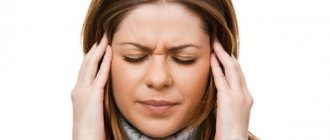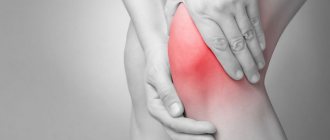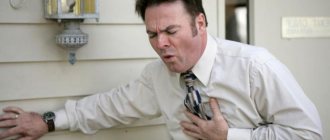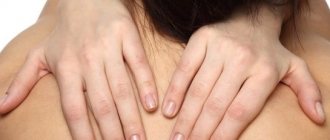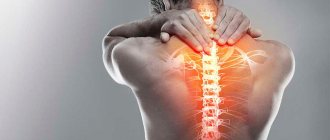The main causes of pain under the left shoulder blade
There are many causes of pain, but they can all be divided into 2 groups:
- Pain associated with pathologies of the musculoskeletal system. Pain under the left shoulder blade can be caused by osteochondrosis of the cervical or thoracic region, intercostal neuralgia, osteomyelitis, bone tuberculosis, scapula injuries, rib fracture or crack, myofascial or scapulocostal syndrome, glenohumeral periarthritis.
- Pain that occurs due to diseases of the internal organs. Pain under the left shoulder blade can be a symptom of heart disease, bronchopulmonary system, gallbladder, stomach ulcers, esophageal spasm, exacerbation of pancreatitis.
Rare pathologies that cause pain radiating to the shoulder blade include splenic rupture. This pathology requires immediate surgical treatment, since massive abdominal bleeding occurs with a risk of death.
No less dangerous for the body is pain in the back on the left under the shoulder blade, which develops against the background of cardiac diseases:
- dissection of an aneurysm of the ascending aorta;
- cardiac ischemia;
- angina pectoris;
- pericarditis, myocarditis, pericarditis;
- myocardial infarction.
Pain in the left shoulder blade from the back, which radiates to the arm and chest area, may indicate heart disease. Numbness of the limb often occurs. Depending on the disease, accompanying symptoms appear: lack of air, compression of the throat, squeezing of the chest, a feeling of cardiac arrest.
Pain under the left shoulder blade may appear during pregnancy due to increased stress on the back
Let's take a closer look at the main causes of pain under the shoulder blade from the back on the left.
Gallbladder diseases
With cholecystitis and cholelithiasis, heaviness appears in the right side, pain radiating under the shoulder blade on the left. An acute attack of inflammation of the gallbladder causes severe pain, nausea, vomiting, and increased body temperature. If it is provoked by obstruction of the bile ducts by a stone, the pain syndrome occurs as biliary colic.
With chronic inflammation, the nature of the pain is aching. Unpleasant sensations appear after eating fatty foods, with long breaks between meals.
Relapses of attacks can occur after physical or nervous strain, against a background of stress.
Subphrenic abscess
It is an accumulation of pus under the diaphragm. Most often, an abscess forms on the right side, but left-sided localization is also possible. The pathology is manifested by the following symptoms:
- pain in the left side, radiating under the scapula to the sternum;
- acute pain in the chest, which intensifies when inhaling;
- high body temperature;
- hiccups;
- increased sweating;
- nonproductive cough;
- dyspnea.
Without treatment, the disease can cause empyema, pneumonia, and lung abscess.
Bronchopulmonary diseases
Diseases of the lower respiratory tract (bronchi, lungs and pleura) cause both chest and scapular pain, which are always complemented by a specific bronchopulmonary clinical picture:
- increased body temperature;
- weakness, lethargy;
- labored breathing;
- chest pain (usually from the affected lung) of moderate intensity, which intensifies when coughing or inhaling;
- cough;
- wheezing.
Pain syndrome in the back of the back in the area of the left shoulder blade most often occurs with pneumonia, dry pleurisy, pneumothorax, acute bronchitis or abscess of the left lung.
With tumors, back pain in the area of the left shoulder blade is not accompanied by fever and high temperature, but there is a cough and breathing problems
Kidney diseases
Scapular pain may occur due to problems with the right kidney, since it is located close to the scapula. With its inflammation, the formation of purulent infiltrates or stones, the pain is often localized on the right, but can also radiate to the left. The pain is often dull or aching, but can also be sharp. It is paroxysmal, ascending, that is, it rises from the lower back, accompanied by nausea, vomiting, and elevated body temperature.
Diseases of the musculoskeletal system
Problems with the spine and neurological disorders associated with them are the main cause of back pain in the area of the left shoulder blade. Pain can occur with any movement, turning the body, sneezing, breathing, or taking a deep breath. They can radiate into the arm, combined with a crunching sound and limited mobility.
Often pain in the scapula area occurs due to the following diseases:
- cervical and thoracic osteochondrosis;
- herniated intervertebral discs;
- protrusion;
- scoliosis;
- radiculitis.
Against the background of degenerative processes in the spine, not only blood vessels and nerve endings are pinched, but also muscles spasm. Muscle spasm provokes the occurrence of scapular-costal syndrome.
One of the most common causes of pain in the scapula is cervical osteochondrosis. At first, the pain syndrome is mild, but as degenerative changes occur, it becomes acute and shooting. The pain is accompanied by dizziness, tinnitus, blurred vision, and increased blood pressure.
With cervical osteochondrosis, pain radiates to the arm
More rare diseases of the musculoskeletal system that can provoke scapular pain include osteomyelitis, bone tuberculosis, and malignant neoplasms.
Muscle strain and inflammation
The back muscles that surround the shoulder blade support the spine in an anatomically correct position and protect the internal organs that are located nearby. Their inflammation or injury is not only accompanied by pain, but also provokes a decrease in muscle tone and the occurrence of instability in the shoulder.
Intercostal neuralgia
The disease is accompanied by inflammation of the intercostal nerves and appears against the background of the following provoking factors:
- injuries to the ribs or spine;
- hypothermia;
- excessive physical activity;
- osteochondrosis.
The intensity of the pain syndrome depends on the severity of the pathology and the timeliness of treatment. The pain can be aching, but sometimes it hurts so much that you can’t stand it.
It is important to contact a neurologist in time, who will provide qualified and, most importantly, timely assistance, otherwise intercostal neuralgia will cause a person severe discomfort:
- the pain becomes shooting, cutting in nature;
- pain increases when moving your hand, coughing or inhaling;
- numbness occurs in the affected area of the body;
- heart rhythm is disturbed.
A neurologist with more than 10 years of experience sees patients in a medical clinic. Only he can correctly determine what causes the sudden pain under the left shoulder blade - neuralgia or cardiac pathology. It is impossible to make a correct diagnosis on your own.
Diseases or injuries of the scapula
Cracks and fractures of the scapula, glenohumeral arthritis are accompanied by pain, limitation of movement, damage to blood vessels and pinched nerve endings.
Injuries to the scapula are more common among athletes, patients with osteoporosis, and cancer of bone tissue.
What is located in the right side under the ribs in front of a person?
If you go from top to bottom, in this zone there are:
- the lower part of the right lung , covered with membrane;
- the liver lies under the lung - it occupies the entire space behind the right rib;
- the gallbladder lies under the liver bile ducts descend from it and the liver ;
- Below is the cecum with an appendix - the appendix ;
- closer to the back at the lumbar level are the kidneys , from which the ureters follow into the pelvis;
- In women, the ovaries .
It is in these organs that pain in the right side often occurs.
Among all the possible causes of pain in the right side, we can distinguish conditions that require urgent medical attention and those that do not require it.
Types of pain under the shoulder blade on the left
Before proceeding with diagnosis and treatment, it is important to understand the nature, localization, intensity of pain, their connection with movement, breathing, and eating. If it hurts below the left shoulder blade after eating, then heart pathologies and diseases of the musculoskeletal system can be ruled out. The cause of pain is diseases of the gallbladder, pancreas, and stomach.
The nature of the pain syndrome can be girdling, acute, burning, increasing, aching, dull, sharp.
Aching pain in the left shoulder blade
It can be constant or periodic, indicating both pathologies of internal organs and diseases of the spine. Without treatment, it can turn into a stabbing, burning sensation. Attacks more often occur when raising an arm, physical activity, or staying in one position for a long time.
Appears with scoliosis, chronic cholecystitis, scapular-costal syndrome, intervertebral disc herniation, initial stages of cervical osteochondrosis, bruises and other mild injuries, intercostal neuralgia.
Acute pain under the left shoulder blade
This is a severe pain syndrome in the back below the shoulder blade, which limits movement and makes breathing difficult. Characteristic for myocardial infarction, bursitis of the shoulder joint, exacerbation of osteochondrosis, spondylosis, hernia, subphrenic abscess, pleurisy, acute cholecystitis, intercostal neuralgia.
In case of myocardial infarction, pain under the scapula from behind is not relieved by analgesics, it decreases after taking nitroglycerin
Sharp pain in the area of the left shoulder blade
It may occur suddenly or be the result of prolonged aching pain. Shooting, sharp pain is a sign of osteochondrosis, hernia, trauma, intercostal neuralgia, tuberculosis of the scapula, aortic aneurysm, perforated gastric ulcer, radiculitis.
Stitching pain behind the left shoulder blade
It manifests itself as lumbago, which is typical for pinched nerve endings in diseases of the musculoskeletal system. If it is accompanied by compression of the chest and lack of air, then myocardial infarction or lung abscess cannot be ruled out.
With a perforated stomach ulcer, pain occurs, as if stabbed with a knife.
Nagging pain in the left side of the back under the shoulder blade
Inherent in most pathologies of the musculoskeletal system, as well as bronchopulmonary diseases.
Constant pain on the left side under the shoulder blade
Such pain does not leave the patient even in a lying position. It interferes with sleeping, breathing, and walking. More often, pain intensifies with physical activity, coughing, and sneezing.
Constant nagging or aching pain occurs with injuries to the spine or scapula, scapular-costal syndrome, bronchopulmonary diseases, pyelonephritis, and oncology. Girdle pain with disorders of the digestive system is characteristic of patients with acute pancreatitis.
Burning pain on the left side of the shoulder blade
It is simply unbearable and occurs with intercostal neuralgia, myocardial infarction, angina pectoris, muscle strain.
Important! If a burning sensation that spreads to the sternum is accompanied by shortness of breath, you should immediately call an ambulance. This is a sign of a heart attack.
How to relieve pain under the left shoulder blade
Pain sensations below the shoulder blade on the left, especially if they are quite intense, interfere with movement and breathing freely, require qualified help, since they pose a threat to human health and life. You cannot ignore them and self-medicate. Taking analgesics, antispasmodics and other painkillers can relieve pain, but will not eliminate the cause, which must be discovered by a doctor.
Important! Emergency care will be required in case of severe pain with increasing intensity and rapid deterioration in well-being.
Which doctor should I consult for pain on the left under the scapula?
At the first painful sensation in the area of the shoulder blade, you should consult a specialist and undergo diagnostics. Since the nature of back pain is often neurological, you should make an appointment with a neurologist.
The doctor will conduct a visual examination, study the patient’s complaints, draw up a clinical picture: the nature and conditions of the pain syndrome (in a lying position, during movement), its intensity, accompanying symptoms.
With glenohumeral arthritis, pain worsens at night, when lying down
To understand exactly why your back hurts, your doctor will prescribe an additional examination:
- laboratory - clinical analysis of blood and urine, which will show the inflammatory process;
- instrumental, necessarily including MRI, since this diagnostic method provides the most accurate information about the condition of the spine, muscle tissue, nerve endings and blood vessels.
You can undergo magnetic resonance imaging using the new 2021 Siemens Symphony 1.5 Tesla device at the SmartMed clinic. Immediately after the examination, the doctor will interpret the results obtained, make a final diagnosis and prescribe effective treatment.
If instrumental diagnostics reveals a pathology that is not within the competence of a neurologist, the doctor will refer the patient to a therapist, pulmonologist, cardiologist, gastroenterologist, traumatologist or other specialists.
Diagnostic measures
Our specialists will make a more precise diagnosis after carrying out the necessary laboratory and instrumental diagnostics using the most modern equipment. When indicated, the following will be carried out:
- blood tests;
- urine test to evaluate kidney function;
- performing liver function tests;
- gastric endoscopy;
- Ultrasound for diagnosing somatic disorders, cardiac and vascular conditions;
- CT scan of the liver, pancreas;
- ECG of the heart;
- X-ray of the sternum.
Based on the fact that pain under the left shoulder blade from the back may not be a symptom of a single disease, a comprehensive examination by several specialists is not excluded. Our clinic offers patients one of the modern comprehensive types of examination - check-up, which includes many types of tests with the smallest set of diagnostic procedures. Timely contact with our specialists and a guaranteed correct diagnosis will help the patient undergo high-quality and successful treatment.
Treatment of pain on the left side of the shoulder blade
All therapeutic measures are aimed at eliminating the root cause and relieving pain. The doctor selects medications based on why the pain in the shoulder blade area occurs.
If the cause is a disease of the musculoskeletal system or its complications, then drug therapy looks like this:
- anti-inflammatory non-steroidal drugs;
- muscle relaxants;
- analgesics;
- local anesthetic agents.
Drug therapy must be supplemented with physiotherapeutic treatment, massage, and therapeutic exercises. A neurologist from the SmartMed clinic draws up a comprehensive therapy program, taking into account the individual characteristics of the patient.
If conservative therapy does not provide the desired therapeutic effect, the patient is indicated for surgery
Recovery from lumbar compression
To release a pinched nerve in the lower back, medication and diet are not enough. A set of additional classes is required. Physiotherapy treatments may be combined with massage specifically designed to help relieve pinched nerves in the lower back. Mud therapy and therapeutic exercises are also used. All measures are aimed at restoring mobility, strengthening muscles, and improving blood supply.
Special exercises to develop the lower back when a nerve is pinched consist of light daily exercise, swimming (necessarily in conditions of a comfortable water temperature). You should absolutely not overload your back. The patient should enjoy performing the techniques, then he will get used to leading an active lifestyle and benefit from it.
In addition to exercise therapy with a trainer, it is useful to perform some movements at home as exercise. The simplest of them are:
- bending forward, to the sides (small amplitude);
- walking with knees pulled up;
- swinging legs (performed lying down, standing);
- bending and pulling the knee joints to the chest (performed lying down);
- clasping your knees with your hands, rolling back and forth on your back;
- twisting the torso to the right, to the left (lying on the mat).
Each session lasts at least ten minutes. At the same time, blood flow and lymph outflow improve, muscles relax, and oxygen supply to tissues increases.
Gymnastics will benefit any person who complains that his back is stuck in the lower back and he does not know what to do in such cases. If there are no serious pathologies, regular exercise will serve as good prevention.
Massage and manual therapy for pinched nerves in the back should be carried out by a specialist with a medical education. You only need to contact professionals so as not to make things worse.
